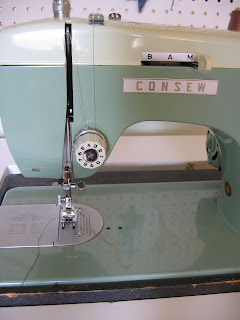
That's me today, because I have a genuine vintage Vogue Patterns cabinet! Ah, Craigslist, you have been good to me before, but this $20 find takes the cake. Even though my long-suffering husband had to drive me to the back side of beyond to get this (as the seller was giving directions, he said, "Now here's where it's helpful to have a four wheel drive truck"--how fortunate that we do), and even though wrestling it into my sewing room closet was extremely difficult and even though I had to reorganize all my precious closet stuffings, I am completely thrilled.
The Vogue Pattern Company of years gone by was no slouch when it came to specifying a cabinet. The action on these drawers is smooth. Now I can thumb through my patterns with the greatest of ease.

And don't worry--only two of these drawers hold patterns. I do have a goodly collection, but not five drawers worth. The top drawer has leather, the next is interfacing (what heaven to have a good place for it!), then patterns, then gifts and sewing machine repair stuff.
In actual sewing news, I am so pleased to show you this blanket. The sixties-era wool was a $6 yard sale purchase, and the similar-vintage butterfly print came from the sale of a fabric collector, Lisa Shoemaker. I love the two together so much. I know that binding a blanket in cotton isn't the typical choice, but really, why not? This binding tutorial from Crazy Mom Quilts tells you nearly everything you need to know about how to make a binding. I wanted to see as much of the butterfly print as possible, so I cut a 6" cross grain binding for a finished binding width of 1 1/2".

I get that quilters favor handstitching the binding on the back side, but I don't totally understand why. This three-step zigzag looks good to me.



